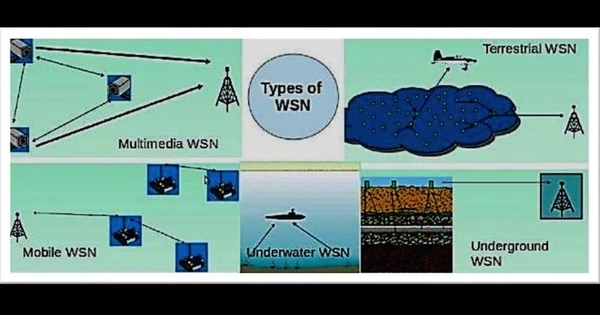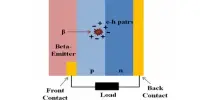A sensor is a device that responds to and detects some type of input from both physical and environmental conditions, such as pressure, heat, light, and so on. The sensor’s output is usually an electrical signal that is sent to a controller for further processing.
A wireless sensor network is a network of devices that can communicate information gathered from a monitored field via wireless links. The data is routed through multiple nodes before being connected to other networks such as wireless Ethernet via a gateway.
Types of Wireless Sensor Networks
There are five types of Wireless Sensor Networks depending on the environment. Different Types of WSNs are:
- Terrestrial Wireless Sensor Networks:
Terrestrial WSNs are used to efficiently communicate base stations and consist of thousands of wireless sensor nodes deployed either unstructured (ad hoc) or structured (pre-planned). In an unstructured mode (ad hoc), sensor nodes are distributed at random within a target area dropped from a fixed plane. The structured or preplanned mode takes into account optimal placement, grid placement, and 2D and 3D placement models.
The battery power in WSNs is limited; however, the battery is equipped with solar cells as a backup power source. WSNs conserve energy by employing low duty cycle operations, optimal routing, minimizing delays, and so on.
- Underground Wireless Sensor Networks:
Underground wireless sensor networks are more expensive than terrestrial WSNs in terms of deployment, maintenance, equipment cost considerations, and careful planning. In terms of deployment, maintenance, and equipment costs, as well as careful planning, underground wireless sensor networks are more expensive than terrestrial WSNs.
Underground Wireless sensor networks UWSNs are made up of several sensory nodes that are hidden in the ground and used to monitor underground conditions. WSN networks are made up of several sensor nodes hidden in the ground that monitor underground conditions. Additional sink nodes are placed above the bottom to transfer data from sensor nodes to the base station. These underground WSNs that are installed in the ground are difficult to recharge. To relay information from the sensor nodes to the base station, additional sink nodes are located above the ground.
The sensor battery nodes equipped with limited battery power are also difficult to recharge. Additionally, the underground environment makes wireless communication a challenge because of the high attenuation and signal loss level.
- Underwater Wireless Sensor Networks:
Water covers approximately 70 percent of the earth’s surface. These networks include a number of sensor nodes and vehicles that are deployed underwater. Data from these sensor nodes is collected using autonomous underwater devices and vehicles.
A long propagation delay, as well as bandwidth and sensor failures, may pose a challenge to underwater communication. Underwater, WSNs have a limited battery that cannot be recharged or replaced. The development of underwater communication and networking techniques is required to overcome the difficulty of energy conservation for underwater WSNs.
- Multimedia Wireless Sensor Networks:
Multimedia wireless sensor networks are proposed to enable the tracking and monitoring of multimedia events such as video, imaging, and audio. Low-cost sensor nodes with cameras and microphones are used in these networks. These Multimedia WSN sensory nodes are linked together via a wireless connection for data retrieval, compression, and correlation.
High bandwidth requirements, high energy consumption, processing, and compressing techniques are some of the challenges with Multimedia WSNs. Furthermore, high bandwidth is required for multimedia content to be delivered properly and easily.
- Mobile Wireless Sensor Networks MWSNs:
Mobile WSN networks are made up of sensor nodes that can move independently and interact with the physical environment. The mobile nodes can also compute, sense, and communicate.
Static sensor networks are far less versatile than mobile wireless sensor networks. Mobile WSNs have advantages over static WSNs in terms of better and improved coverage, superior channel capacity, higher energy efficiency, and so on.
















